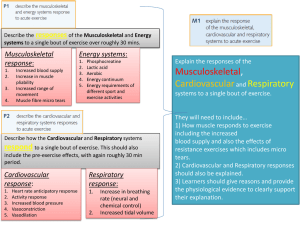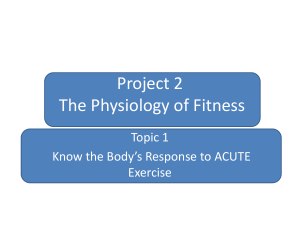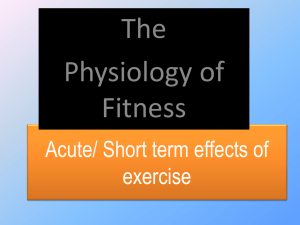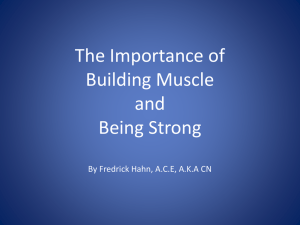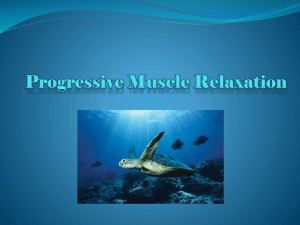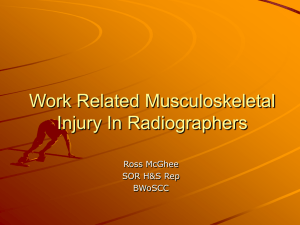Acute exercise and the body`s response
advertisement
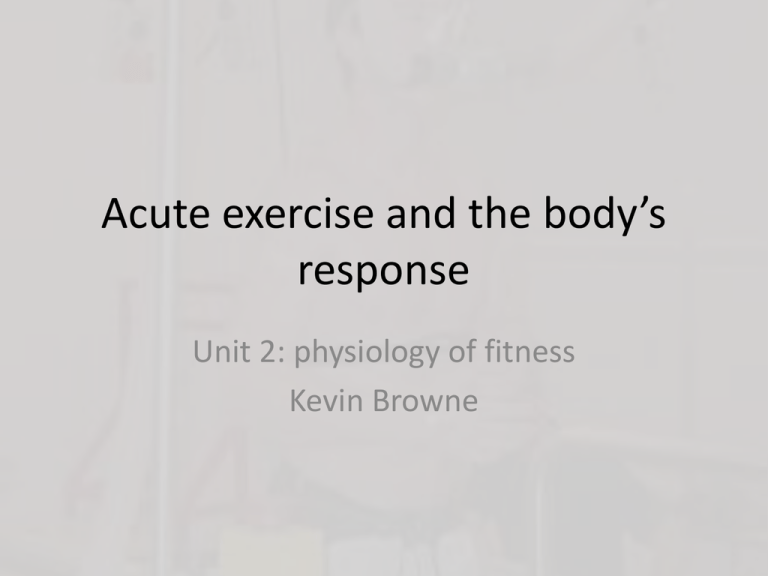
Acute exercise and the body’s response Unit 2: physiology of fitness Kevin Browne Learning Aims • In relation to the assignment P1 P2 M1 Describe the musculoskeletal and energy systems response to acute exercise Describe the cardiovascular and respiratory systems response to acute exercise Explain the response of the musculoskeletal, cardiovascular and respiratory systems to acute exercise Learning aims • So what do you think that you should be able to do by the end of the lesson? • What is meant by the term “acute” • Acute means quick onset, something that happens suddenly • Chronic? • Chronic is something that happens over time or is persistent • Exercise places different demand on the body when compared to rest • The changes are dependent on a number of things such as intensity, duration, the muscles being used, external and internal environment/situation • Using the points above use an example to explain the acute changes • Acute responses will affect all 4 major systems which are: • Musculoskeletal system • Energy system • Cardiovascular • Respiratory Task • You will be split into 4 groups of 2 • In 2s you will research the acute response of exercise to your allocated system • You will record key information (what sort of things do you think you will need to record) both pairs • Then the pairs will split and join with 3 other researchers forming a group of 4. you will then teach the others about your system until all 4 systems have been covered. • Group discussion. Hover over a hexagon for more information Muscle fibre micro tears Blood supply Effects Range of movement Muscle pliability Musculoskeletal responses to acute exercise Blood supply Muscle fibre micro tears Blood supply The temperature and metabolic activity in the muscles increases as you exercise. To meet the increased demand of oxygen by the muscles, blood supply increases through capillary dilation. Effects Range of movement Muscle pliability Musculoskeletal responses to acute exercise Muscle pliability As the muscles get warmer they become more pliable. This reduces the risk of injury. Muscle fibre micro tears Blood supply Effects Range of movement Muscle pliability Musculoskeletal responses to acute exercise Range of movement Exercise stimulates the production of synovial fluid into the joint. The fluid also becomes less viscous and the range of movement at the joint increases. Muscle fibre micro tears Blood supply Effects Range of movement Muscle pliability Musculoskeletal responses to acute exercise Muscle fibre micro tears Muscle fibre micro tears Blood supply Effects Range of movement The stress of exercise causes tiny micro tears in the muscle fibres. These cause swelling in the muscle tissue and muscle soreness. The soreness felt a few hours after exercise or the next day is often referred to as DOMS (delayed onset muscle soreness). Muscle pliability Musculoskeletal responses to acute exercise Energy systems • This should only be a recap • When you begin to exercise your body must immediately adjust to the change in activity level. Energy production must increase to meet demand with changes to the predominant energy system and fuel source occuring throughout the exercise in order to maintain the required level of performance. Response to anaerobic exercise • In order to immediately meet the sudden higher energy demand, stored ATP is the first energy source. This lasts for approximately 2 seconds. • When stored ATP is broken down into ADP + P, the rising ADP level stimulates Creatine Kinase to begin the breakdown of Phosphocreatine. • As discussed on the energy systems page the ATP-PC system can only last 8-10 seconds before PC stores are depleted. • The lactic acid system (Anaerobic glycolysis) must then take over as the predominant source of energy production. High intensity (but submaximal) exercise can last for between 3 and 5 minutes using this system • If the exercise continues at a high intensity, and so Oxygen is not available at a fast enough rate to allow aerobic metabolism to take over, the production of lactic acid will reach the point where it interferes with muscular function. This is called the Lactate threshold. • Muscles begin to fatigue when ATP resynthesis can no longer match Responses to aerobic Exercise • Due to the necessity of Oxygen being present for aerobic metabolism, the first few minutes of low to moderate intensity exercise are powered by anaerobic metabolism. • Continued low to moderate intensity exercise is then fuelled by carbohydrate and fat stores using aerobic metabolism. • The intensity and duration of exercise determines which fuel source is used. Fat metabolism is a slow process and so can only be used as fuel for exercise at less than 60% VO2 max. • Carbohydrate is a much faster fuel source and so can be used for exercise up to 80% (in trained individuals). • Carbohydrate stores within the muscle and liver can fuel exercise for up to 80 minutes. As carbohydrate stores get lower, the body has to rely more and more on fat stores. • The intensity of exercise which can be maintained drops as fat cannot supply the required amount of energy. • www.teachpe.com Prior to the start of exercise the heart rate usually increases. This is caused by the release of neurotransmitters in the blood known as adrenaline and noradrenalin. This rise in heart rate is known as the anticipatory heartrate response. Blood pressure is the pressure of the blood against the artery walls. During exercise the systolic blood pressure rises progressively while the diastolic stays the same or decreases slightly. CV response Prior to and at the start of exercise the nerve centres in the brain can detect cardiovascular activity and adjust the frequency and strength of the hearts contractions. At the same time blood flow is altered in proportion to the intensity of the activity. This is known as the activity response. Blood flow to tissues that are not needed during exercise can also be shut down to temporarily lessen their supply. This is achieved through the constriction of the blood vessels and is known as vasoconstriction. Blood flow will increase (to meet the increased oxygen demand). This is achieved through the dilation of the blood vessels and known as vasodilatation. Respiratory system • During exercise there is an increased production of carbon dioxide. The respiratory system is very sensitive to this, yet insensitive to the falling levels of oxygen. To combat the increase in carbon dioxide levels our breathing rate increases in an effort to expel this. As we breathe faster and deeper we take in more air per breath. The amount of air we breathe in and out in one breath is known as tidal volume. Tidal volume increases during exercise to allow more air to pass through the lungs. During exercise the capillary network surrounding the alveoli expands, increasing blood flow to the lungs and a greater pulmonary diffusion. During exercise your muscles demand more oxygen and produce more carbon dioxide. This stimulates an increase in breathing rate, and breathing becomes faster and deeper. Breathing is controlled by neural and chemical factors. Increases in the rate and depth of breathing are detected by stretch receptors in the lungs, which signal the respiratory centres of the brain to send nerve impulses to the respiratory muscles to control the breathing rate and tidal volume Respiratory response Question Time • In 2s write 3 questions that cover any of the 4 systems that we have covered in lesson. • Join up with another pair and pick 4 questions out of the combined 6 • 4 vs 4 • Losers will have a forfeit • Have you met your learning aim?
